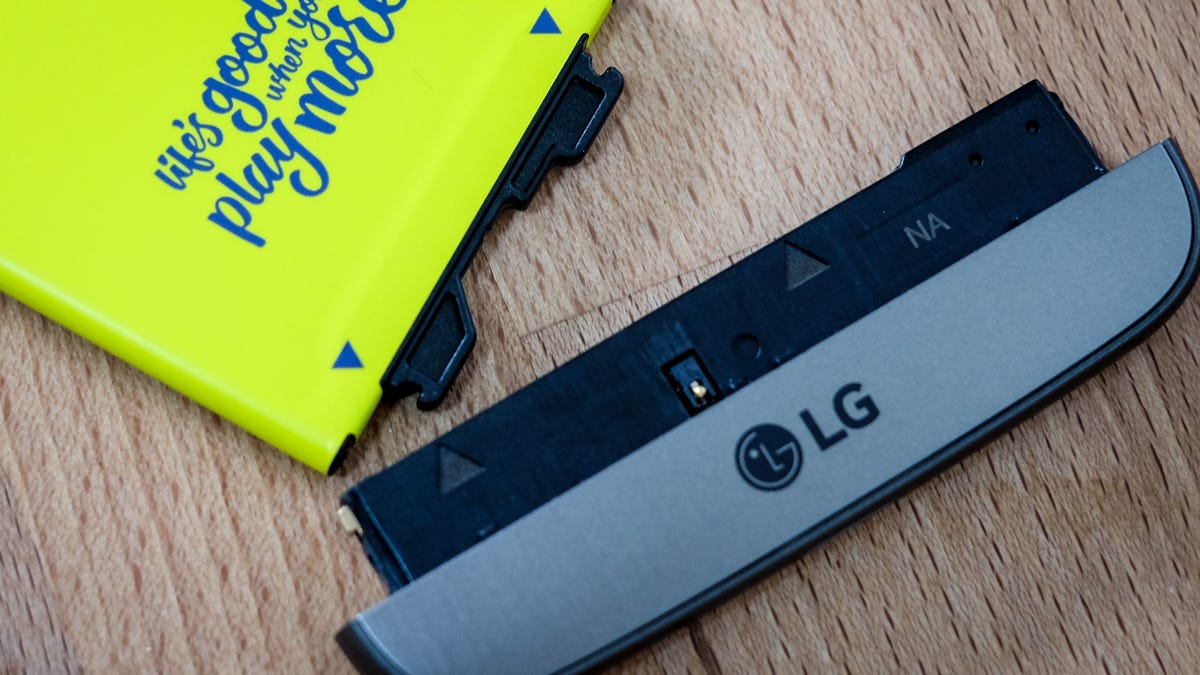LG can't follow Apple, says VP, 'We have to be different'
For LG, the modular G5 phone is the first step in a new strategy. Here's why.

The LG G5 is a different kind of phone, and that's exactly how LG wants it.
In an industry where nonremovable batteries are increasingly the norm, the G5's battery slides out, allowing you to replace it. Even more wildly, that battery attaches to modules you can swap in to give the phone better audio and a sturdier camera grip. And then there's LG "Friends", a growing ecosystem of devices that work with the G5 phone, including a 360-degree camera, streaming LTE action camera and a rolling robot.
You're not going to see any of that on Apple's iPhone 6S, Samsung's Galaxy S7 or HTC's M10.
"We have to speak up in the marketplace that we are different than Apple and Samsung," said Chris Yie, LG's marketing vice president, when I spoke with him at LG's headquarters in Seoul, South Korea as part of my tech tour of Asia.
VR headsets, robot balls and snap-on phone gadgets: Say hello to LG's amazing new G5 accessories
See all photos"In terms of earnings, we aren't in the top three, but in terms of product [quality], we are in the top three," Yie continued. "We cannot follow what they're doing; we have to be different."
This is where LG hopes that the G5's modular capabilities and "Friends" accessories stand out as unique, playful and, most importantly, functional.
Getting over the innovation slump
Innovation has been a major stumbling block for phonemakers. Phone shapes and colors vary little, and while high-end devices tend to be faster and contain better cameras than less-expensive handsets, speed and photographic acuity are generally more similar than they are different. The same can be said for the two major mobile operating systems: Android and iOS.
Read more of Jessica's tech travels through Asia!
This features plateau leaves companies like LG grappling for ways to stand out. Motorola has its online color customization; Samsung, its Note series with stylus and curved-screen Edge phones. Huawei's P9 has two rear camera lenses, and so does the G5.
But just because LG is trying something different with its modular G5 and "Friends," doesn't mean it will catch on in the way LG needs in order to grow its position in an industry where it's hard to break away from the pack.
"In an increasingly commoditized smartphone market," said Wayne Lam, director and principal analyst at IHS, "Winners need to grow [to] build scale. Aside from Apple, Samsung and potentially Huawei, there are very few [manufacturers] left that can create sustainable growth and profitability."
Despite LG's relentless competition, LG's Yie is optimistic about the G5's success.
"So far, the reaction from the market has been quite bigger and more excited than we expected," he said. Whether that translates to real-world sales is still to be seen.
LG's 'Friends' are sticking around
LG wouldn't share early sales numbers, especially because the G5 is just starting to show up on shelves worldwide, but the company has hosted events in Korea and San Francisco in the hopes of wooing developers to create more modules and accessories. More developer conferences are likely in countries like Russia and India.
CNET didn't like LG's first VR headset, but it remains an important part of the company's strategy going forward.
According to LG, the modules and "Friends" ecosystem aren't some flash in the pan. They're a crucial part of long-term strategy, whether individual devices go boom or bust.
The Hi-Fi Plus module, which swaps into the phone's chin and amps up the LG's battery, is already making money, LG's marketing VP Yie told me. Meanwhile, CNET reviewers panned the company's VR headset for the G5.
"Nobody can be confident that all nine Friends will be successful," Yie said of the add-on devices LG has launched so far. "Whether it's successful or not, VR is one of the very important devices we should keep in our ecosystem."
It's an ecosystem that you can bet on LG to nurture as part of a unique identity. For now at least, until competitors follow suit and dig into ecosystems of their own (Samsung has done this to a lesser extent with the Gear VR headset and Gear 360 camera).
LG has a long way to go, and the G5 and "Friends" enter the market already flawed. Swapping modules disengages the battery and powers off the phone, and modules could just as easily connect through Bluetooth rather than physically latch on (though it's certainly more convenient to carry one device rather than two). I'm not convinced this approach will turn LG's fortunes, but I do applaud the company for trying its hand at accessories more substantial than a phone case.
Modules and "Friends" may not bring the company the kind of success it covets, but in the short term at least, LG is sticking with its gameplan.

